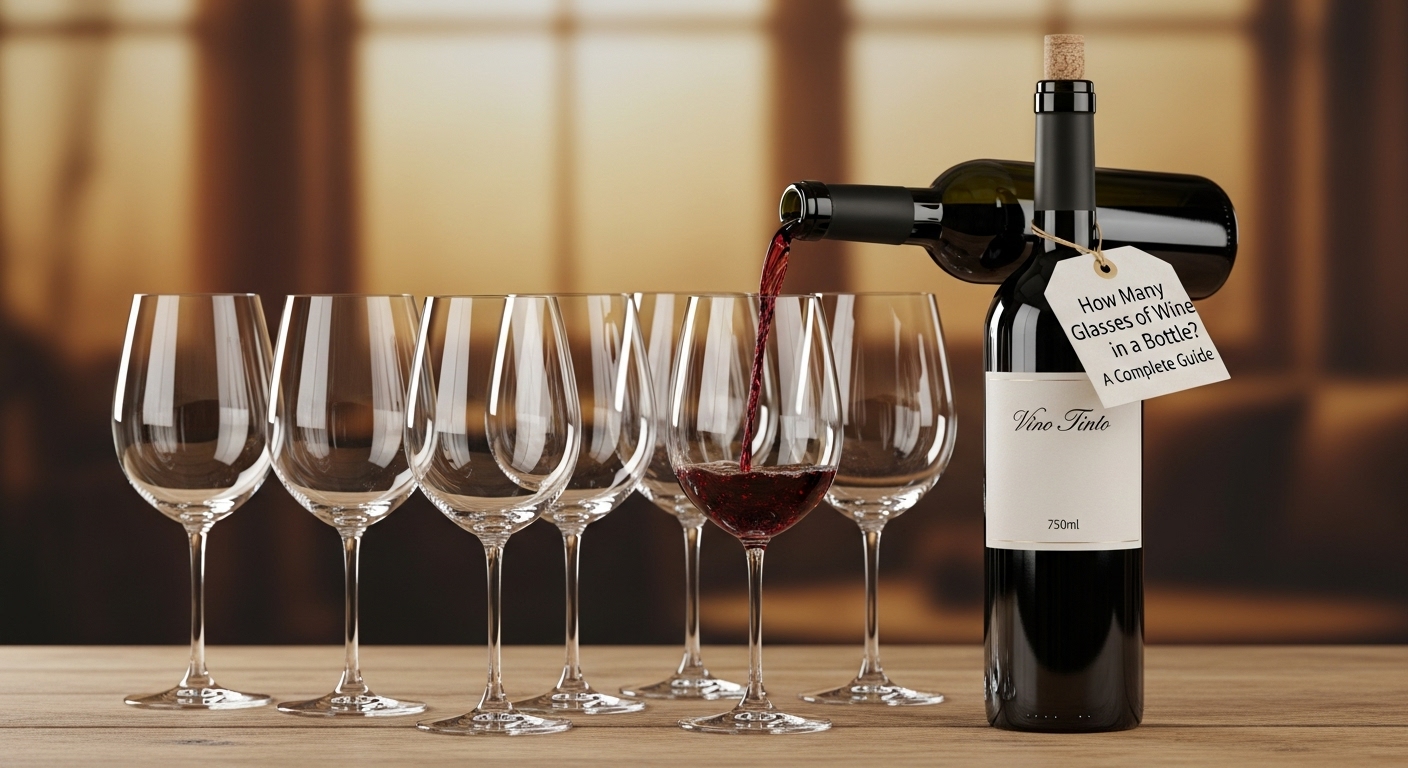BLOG
How Many Glasses of Wine in a Bottle? A Complete Guide

If you’ve ever hosted a dinner party or planned a wine tasting, you’ve probably asked yourself: how many glasses of wine in a bottle? Knowing the answer can help you plan portions, pairings, and your budget. While the short answer is about five glasses per standard bottle, the real answer depends on glass size, wine style, and serving purpose.
In this article, we’ll explore standard wine measurements, different bottle sizes, pouring tips, and future trends in wine consumption so you’re always prepared.
The Standard Bottle of Wine
A standard wine bottle contains 750 milliliters (ml) or roughly 25 fluid ounces. This is the global standard for most still wines, sparkling wines, and dessert wines.
At a standard pour of 5 ounces per glass, you’ll get approximately five glasses of wine from one 750 ml bottle. However, variations in glass size and pour style can shift this number up or down.
Standard Serving Size: How Many Glasses of Wine in a Bottle
Here’s a quick breakdown:
| Bottle Size | Volume (ml) | Average Glasses (5 oz pour) |
|---|---|---|
| Standard Bottle | 750 ml | 5 glasses |
| Half Bottle (Split) | 375 ml | 2.5 glasses |
| Magnum (Double) | 1.5 L | 10 glasses |
| Jeroboam (Party Size) | 3 L | 20 glasses |
This table shows why the keyword “how many glasses of wine in a bottle” matters for planning events and understanding wine service.
Factors That Affect the Number of Glasses
Several factors can change the number of glasses you’ll pour from one bottle:
- Glass Size: A larger wine glass might hold 8–10 ounces, but you should still pour about 5 ounces for proper tasting.
- Type of Wine: Sparkling wines are often served in smaller pours (4 ounces) to preserve bubbles. Dessert wines may be poured even smaller (2–3 ounces).
- Pour Style: Free-pouring versus measured-pouring can make a big difference.
- Event Style: Casual parties may see larger pours, while tastings feature smaller servings.
Understanding these factors helps you plan accurately.
Why the Standard Serving Matters
Knowing how many glasses of wine in a bottle is important because:
- Budgeting: Helps you estimate how many bottles you’ll need for an event.
- Health and Moderation: Standard pours make it easier to track alcohol intake.
- Taste Experience: Proper serving sizes enhance aroma, flavor, and enjoyment.
- Professional Service: Restaurants and bars use standardized pours for consistency.
This knowledge turns you into a more confident host or wine enthusiast.
Wine Glass Sizes and Their Impact
Wine glasses come in a range of shapes and volumes:
- Red Wine Glasses: Larger bowls (12–22 ounces) to aerate wine.
- White Wine Glasses: Smaller bowls (8–14 ounces) to preserve cooler temperatures.
- Sparkling Wine Glasses (Flutes): Narrow and tall to maintain bubbles.
- Dessert Wine Glasses: Small (2–6 ounces) for concentrated flavors.
Regardless of the glass size, sticking to the standard pour ensures you’ll still get roughly five glasses from a bottle.
Pouring Tips for Perfect Portions
To consistently pour the right amount:
- Use a Wine Measure or Jigger: A 5-ounce measuring tool guarantees accuracy.
- Mark Glasses Discreetly: Some hosts place a small mark on glasses to indicate the right fill level.
- Practice Free Pouring: With experience, you’ll naturally pour the correct amount.
- Consider a Wine Decanter: It can help portion wine evenly among guests.
These tips help you maintain control over serving sizes, reducing waste and ensuring fairness.
How Many Glasses of Wine in Different Bottle Types
We’ve already touched on this, but it’s worth revisiting the most popular bottle sizes:
- Half Bottles (375 ml): Ideal for a small dinner or a single serving for two people.
- Magnums (1.5 L): Great for parties; equivalent to two standard bottles.
- Large Format Bottles: Jeroboam, Methuselah, Salmanazar, and Nebuchadnezzar sizes can pour dozens of glasses — a showstopper at celebrations.
Knowing these formats allows you to confidently answer the question “how many glasses of wine in a bottle” for any event.
Pairing Wine Service with Food
The number of glasses also depends on food pairing:
- Tasting Menus: Smaller pours let guests try multiple wines.
- Main Courses: Full pours (5 ounces) complement heartier meals.
- Dessert Courses: Smaller pours (2–3 ounces) work best with sweet wines.
Balancing pour size with food pacing enhances your guests’ experience.
Health Guidelines and Moderation
When thinking about how many glasses of wine in a bottle, it’s wise to remember moderation:
- A standard 5-ounce pour of wine is considered one drink in many health guidelines.
- Most experts recommend moderation — up to one glass per day for women and two for men, depending on health status.
- Spacing out servings and drinking water between glasses can reduce risk and enhance enjoyment.
Understanding serving sizes can help you enjoy wine responsibly.
Looking Ahead: The Future of Wine Serving and Bottles
Looking ahead, the wine industry is evolving in ways that affect how many glasses of wine in a bottle:
- Smaller Bottles: With more focus on moderation, half-bottles and single-serve cans are growing in popularity.
- Wine on Tap: Restaurants and bars are adopting kegged wine systems for consistent pours and less waste.
- Smart Pouring Technology: Apps and measuring devices are emerging to help hosts and bartenders pour precise servings.
- Sustainable Packaging: Lightweight bottles and alternative containers reduce carbon footprints.
These trends may change not only how wine is served but also how it’s produced and packaged.
Conclusion
The answer to how many glasses of wine in a bottle is straightforward at first glance — about five glasses from a standard 750 ml bottle. But glass size, pour style, wine type, and event format can shift that number.
By understanding standard serving sizes and planning accordingly, you can enhance your guests’ experience, manage your budget, and enjoy wine responsibly. Looking ahead, changing packaging and technology may make wine service even more precise and sustainable.
Whether you’re planning a dinner party, running a restaurant, or just curious about wine, knowing how many glasses of wine in a bottle will help you pour with confidence.
BLOG
Arbiter Live: Transforming Sports Management and Digital Leadership

In today’s rapidly evolving digital age, success is no longer measured solely by technological advancements or organizational growth. The most impactful platforms are those that bridge operational efficiency with community value, shaping ecosystems that thrive while uplifting the individuals they serve. One such innovative solution is Arbiter Live, a platform that has redefined how sports organizations, schools, athletes, and referees interact in a transparent, streamlined, and modernized environment.
This article explores Arbiter Live’s journey, its approach to integrating technology with purpose, and why it represents the new generation of digital platforms reshaping sports management and beyond.
What is Arbiter Live?
Arbiter Live is a digital sports management platform designed to simplify and centralize scheduling, communication, and coordination within athletics. While its tools are widely used by schools, leagues, and referees, what sets Arbiter Live apart is its holistic approach: it is not just about logistics, but about fostering trust, accountability, and engagement across entire sports communities.
The platform represents a growing movement in digital transformation—where operational excellence and positive user experiences are not mutually exclusive but deeply intertwined.
A Technology Philosophy Rooted in Purpose
At the heart of Arbiter Live’s success is a philosophy that balances innovation with human-centered design. Its mission goes beyond just digitizing workflows; it focuses on strengthening connections in the sports ecosystem. Key aspects of this philosophy include:
- Transparency: Ensuring accurate schedules and publicly visible updates that eliminate confusion.
- Accessibility: Making information easy to find for athletes, parents, and fans.
- Collaboration: Creating a seamless network between administrators, coaches, referees, and families.
This approach reflects the growing recognition that digital platforms must function not only as tools but as community enablers.
Bridging Efficiency with Community Impact
What makes Arbiter Live especially noteworthy is its ability to merge advanced scheduling technology with tangible benefits for the sports community. Examples of this approach include:
- For Schools: Administrators gain a centralized system that simplifies scheduling, reporting, and compliance.
- For Coaches: A clear overview of team calendars ensures smooth communication and reduced scheduling conflicts.
- For Referees: The system assigns, tracks, and manages officiating assignments, ensuring fairness and efficiency.
- For Families & Athletes: Parents and players get real-time access to schedules, changes, and important updates.
By embedding these values into its framework, Arbiter Live creates a virtuous cycle: streamlined operations lead to better participation, and stronger community engagement drives long-term success.
Influence in the Digital Age
In today’s sports environment, where information travels fast, Arbiter Live recognizes the importance of digital accessibility and real-time engagement. By offering a platform that prioritizes ease of use, the service empowers communities to stay informed and connected.
This digital influence enables Arbiter Live to:
- Reach broader audiences with transparent, accurate scheduling.
- Reduce stress for parents and students navigating multiple commitments.
- Inspire other organizations to adopt community-centered digital solutions.
Much like digital leadership in business, Arbiter Live demonstrates how technology can be used not just for operational gains but for fostering trust and inclusion.
A Model for the Future of Sports Management
The rise of Arbiter Live reflects broader shifts in expectations around technology, particularly among younger generations who demand:
- Authenticity: A reliable platform that delivers on its promises.
- User-friendliness: Interfaces that are intuitive, mobile-friendly, and adaptable.
- Community Awareness: Recognition that technology must serve people, not just processes.
By embodying these principles, Arbiter Live positions itself as both a tool and a leader—guiding organizations toward a future where digital efficiency naturally aligns with community well-being.
Challenges and Opportunities
Like any platform navigating today’s digital transformation, Arbiter Live faces challenges:
- Balancing complexity with simplicity: Offering robust features without overwhelming users.
- Maintaining real-time accuracy: Ensuring updates are instantly reflected across all stakeholders.
- Convincing traditional organizations: Encouraging adoption among schools or leagues still reliant on outdated methods.
Yet these challenges also present opportunities. Arbiter Live’s adaptive design allows it to evolve quickly, integrating new technologies like mobile optimization and cloud-based security to deliver even greater value.
Innovation Beyond Scheduling
While Arbiter Live is most recognized for its scheduling efficiency, its influence extends far beyond logistics. Its innovative framework provides:
- Data-Driven Insights: Analytics that help administrators make informed decisions about participation, officiating, and resource allocation.
- Improved Communication: Streamlined channels between coaches, athletes, and families reduce misunderstandings.
- Trust & Accountability: By making schedules public, the platform minimizes disputes and increases reliability across all levels.
These innovations highlight Arbiter Live’s ability to transform sports management into a more transparent, collaborative, and user-friendly process.
Arbiter Live and the Power of Digital Communities
Arbiter Live demonstrates how digital tools can serve as anchors for community-building. Sports, at their core, are about more than competition—they are about shared experiences, teamwork, and personal growth. Arbiter Live ensures that the organizational side of sports never becomes a barrier but instead acts as an enabler of stronger connections.
By simplifying administrative tasks, it gives coaches and athletes more time to focus on what truly matters: training, teamwork, and the love of the game.
Looking Ahead
As it continues to grow, its trajectory signals a new paradigm in sports management technology—one that values reliability, inclusivity, and user empowerment alongside efficiency and growth. In a world where athletes, parents, and organizations increasingly demand transparency and trust, platforms like Arbiter Live are well-positioned to set the standard.
The future of sports management will not be defined by paperwork, confusion, or outdated systems, but by solutions like Arbiter Live that streamline processes while strengthening communities.
Conclusion
In an era where leadership and innovation are measured by both impact and inclusivity, Arbiter Live emerges as a model of purpose-driven technology. By actively balancing advanced scheduling tools with community-oriented values, it redefines how schools, referees, athletes, and families engage with sports.
Moreover, just as modern leaders reshape industries with empathy and responsibility, Arbiter Live transforms athletics with efficiency and transparency. Consequently, its journey highlights an essential truth: success in the digital age depends not only on technology, but also on people, purpose, and connection.
Furthermore, with its steady rise, Arbiter Live embodies the next generation of digital leadership in sports. Indeed, it demonstrates that the best platforms empower not just organizations, but entire communities. Ultimately, Arbiter Live proves that technology achieves its fullest potential when it serves both performance and people.
BLOG
Yalla Live: Redefining Connection, Community, and the Digital Future

In today’s rapidly evolving digital world, success is no longer measured solely by technological advancements or market dominance. The most impactful platforms are those that merge innovation with human connection, shaping ecosystems where people not only interact but also thrive together. One such emerging force is Yalla Live, a platform that has gained recognition for its ability to align cutting-edge technology with meaningful engagement.
This article explores Yalla Live’s journey, its approach to integrating entertainment with community, and why it represents the new generation of digital platforms redefining online connection.
What is Yalla Live?
Yalla Live is steadily gaining global attention as a platform that blends real-time interaction, entertainment, and social connectivity. At its core, Yalla Live is not just about broadcasting or streaming—it’s about creating spaces where people can gather, share, and engage authentically.
The platform represents a growing shift in digital culture: online communities are no longer passive consumers but active participants. With Yalla Live, users experience connection as something dynamic, meaningful, and socially enriching.
A Philosophy Rooted in Connection
At the heart of Yalla Live’s success is its commitment to community-first practices. Unlike platforms that prioritize only growth metrics, Yalla Live emphasizes building experiences rooted in:
- Authentic Interaction – enabling genuine conversations across borders.
- Accessibility – ensuring diverse audiences can participate without barriers.
- Cultural Exchange – fostering spaces where global users learn from one another.
This philosophy reflects the recognition that modern digital spaces cannot thrive on algorithms alone—they must be inclusive ecosystems where users feel valued and heard.
Bridging Technology with Social Impact
What makes Yalla Live especially noteworthy is its ability to merge advanced streaming technology with tangible social benefits. Instead of being just another entertainment app, Yalla Live positions itself as a community builder.
Examples of this approach include:
- Interactive Features – tools that allow users to collaborate, host discussions, and engage beyond passive viewing.
- Global Community – creating opportunities for people across different regions to connect in real-time.
- Empowerment of Creators – supporting streamers and hosts to grow their digital presence while sharing meaningful content.
By embedding these values, it illustrates how digital innovation can create a cycle of growth—where strong communities drive platform success, and the platform, in turn, nurtures those communities.
Influence in the Digital Age
In today’s hyper-connected world, Yalla Live understands the importance of digital influence. Beyond being a platform, it serves as a stage for conversations, talent, and cultural narratives to reach global audiences.
Through its innovative approach, Yalla Live empowers users to:
- Reach new audiences by broadcasting ideas, performances, and discussions.
- Engage youth who value authenticity and real-time interaction over curated, polished media.
- Inspire participation by fostering inclusive and transparent digital spaces.
This adaptability ensures it stays relevant in a crowded streaming and social networking landscape.
A Model for the Next Generation of Platforms
Yalla Live reflects broader shifts in what users expect from digital platforms, particularly Millennials and Gen Z. These generations prioritize values beyond entertainment—they seek authenticity, cultural diversity, and global perspectives.
Yalla Live embodies these principles by focusing on:
- Authenticity – ensuring content and connections feel genuine.
- Inclusivity – giving diverse voices equal opportunity to shine.
- Global Vision – creating digital bridges across cultural and geographic divides.
By championing these ideas, it has positioned itself as both a trailblazer and a role model for the next era of digital engagement.
Challenges and Opportunities
Like any platform navigating today’s competitive digital ecosystem, Yalla Live faces challenges:
- Balancing growth with user experience.
- Maintaining community trust in an era of misinformation.
- Staying innovative while avoiding feature fatigue.
Yet, these challenges also represent opportunities. It’s commitment to adaptability allows it to transform obstacles into stepping stones for growth. By listening to its users and prioritizing meaningful engagement, it ensures its platform remains sustainable and relevant.
Real-World Impact of Yalla Live
The true influence of Yalla Live can be seen in its practical applications:
- Cultural Events – broadcasting festivals, performances, and discussions that reach global audiences.
- Education & Awareness – hosting conversations on social issues, technology, and lifestyle topics.
- Entertainment – offering interactive experiences that go beyond traditional live streaming.
- Community Building – providing a safe space for individuals to connect around shared interests.
These examples showcase that it is more than a digital trend—it is a framework for reimagining how people connect online.
Looking Ahead
As Yalla Live continues to grow, its trajectory signals a new paradigm in digital engagement—one that values inclusivity, authenticity, and shared growth alongside innovation and technology. In an age where users increasingly demand accountability and connection, Yalla Live is well-positioned to set the standard.
By continually evolving, it proves that the future of digital platforms lies not in one-way broadcasting but in dynamic, community-driven engagement.
Conclusion
It is not just a live-streaming platform; it is a movement redefining what it means to connect in the digital age. By focusing on empathy, inclusivity, and innovation, it creates meaningful experiences that go beyond entertainment.
The lesson is clear: when digital innovation aligns with human connection, platforms like Yalla Live don’t just survive—they thrive, uplifting both individuals and communities along the way.
BLOG
TalktoWendys: Wendy’s Official Survey Guide to Win Free Rewards

TalktoWendys
TalktoWendys (often found at www.talktowendys.com) is the official customer satisfaction survey portal created by Wendy’s. The fast-food giant values customer feedback and uses this platform to understand dining preferences, service quality, and suggestions for improvement.
By completing the survey, customers help Wendy’s enhance its menu and service while also enjoying exclusive perks.
How to Participate in TalktoWendys Survey
Here’s a step-by-step guide to completing the TalktoWendys survey:
- Make a Purchase – Visit a Wendy’s location and keep your receipt handy.
- Visit the Survey Website – Go to www.talktowendys.com.
- Enter Receipt Details – Input the restaurant number, date, and time of your visit.
- Answer Questions Honestly – Share your feedback about food, cleanliness, staff, and service.
- Submit and Receive a Code – At the end, you’ll get a validation code to redeem free food or discounts on your next purchase.
Benefits of Completing TalktoWendys
Taking part in TalktoWendys offers multiple perks:
- Free Food Rewards – Commonly includes a free Dave’s Single burger or BOGO offers.
- Exclusive Discounts – Get special offers on future meals.
- Improved Service – Your feedback helps Wendy’s improve their menu and customer experience.
- Quick & Easy Process – The survey only takes about 5 minutes to complete.
TalktoWendys Rules and Requirements
To ensure eligibility for the TalktoWendys survey, here are some important rules:
- Must be a legal resident of the U.S. or Canada.
- Recent Wendy’s receipt is required.
- One survey per receipt.
- Must be 18 years or older.
- Rewards are not transferable.
Tips to Maximize Your Wendy’s Rewards
If you want to get the most out of TalktoWendys, follow these simple tips:
- Save Every Receipt – Each one gives you another chance for free food.
- Take the Survey Quickly – Most receipts expire within 7 days.
- Be Honest – The more genuine your feedback, the better Wendy’s can serve you.
- Use Rewards Before Expiry – Validation codes usually expire in 30 days.
Final Thoughts
The TalktoWendys survey is a win-win opportunity for both Wendy’s and its customers. While Wendy’s gains valuable insights to improve their services, customers enjoy free food, discounts, and exclusive deals just by sharing feedback.
So next time you dine at Wendy’s, don’t throw away your receipt — visit www.talktowendys.com, complete the survey, and claim your reward.
-

 BLOG1 month ago
BLOG1 month agoWebteknohaber: Your Go-To Source for Technology News
-

 ENTERTAINMENT1 month ago
ENTERTAINMENT1 month ago123movies: Top 5 Truths You Must Know Today
-

 BLOG1 month ago
BLOG1 month agoVezgieclaptezims: Unraveling the Marvels Behind This Unique Concept
-

 BLOG1 month ago
BLOG1 month agoRamneek Sidhu: A Trailblazer in the Digital Marketing Landscape
-

 Home1 month ago
Home1 month agoCinndymovies: All You Need To Know
-

 BLOG1 month ago
BLOG1 month agoPokedle: The Ultimate Pokémon Daily Word Game
-

 BLOG3 weeks ago
BLOG3 weeks agoUvlack: Protective Coating for Strength and Style
-

 BLOG1 month ago
BLOG1 month agoMixmoz.com: Smart Indian Blog for Life Tips & Daily Solutions
